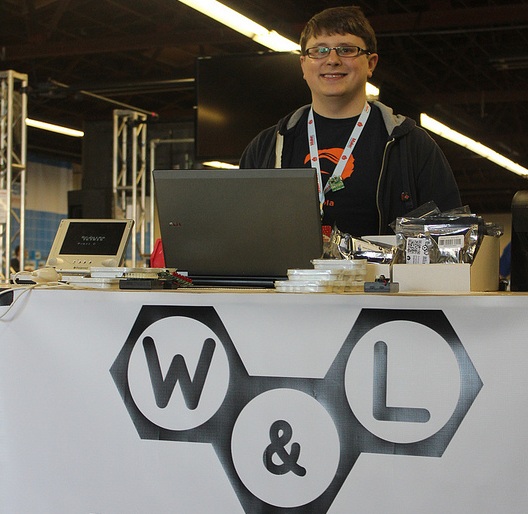Podcast: Play in new window | Download
Subscribe: Apple Podcasts | RSS

Welcome Adam Wolf of Wayne and Layne!
- Wayne and Layne started when Adam and Matthew met…back in 6th grade in Minnesota! Later they both attended the University of Minnesota.
- Adam now works at Digi, the makers of Xbee. More specifically, he works helping people develop embedded solutions at
Etherios (formerly Spectrum). - One of the projects he worked on for an extended period was Android. It’s useful to quickly bolt a GUI onto a product.
- Chris has briefly played with Android using one of the Liquidware dev kits.
- Adam and Matthew developed the Bricktronics shield to offer a low cost entry to combining Lego and Arduino. This was designed with John Baichtal, who co-wrote The Cult of Lego.
- The kit is based on the huge interest in Lego Mindstorms. There are 550 teams FIRST Lego Robotics teams that compete each year…in Minnesota alone! How crazy is that??
- The standard kit includes the NXT, which has an ARM SAM 9 chip on board. The newer EV3 runs full Linux.
- Wayne and Layne had problems with audience culture clash at the beginning, especially before their book MAKE: Lego and Arduino Projects was fully released to the public.
- Adam is not a member of the KiCad Dev team; however, he does a nightly build of KiCad and helps guide others to doing the same.
- He also watches the dev mailing list regularly (an act all in and of itself) and noted that there is talk about change in library lookup (possibly online libraries and immediately EAGLE compatibility)
- This stems from people being paid to work on KiCad, such as the awesome people at CERN.
[tube]http://www.youtube.com/watch?v=zxHDAHpR5Ls[/tube] - There are many new features in the pipeline, it’s all about whether you want to try them out in your test builds.
- Adam and Matthew recently were featured at an event that helps promote STEM for women in Africa. Their Blinky POV kit was featured and has been built all of the world. 10s of thousands have now been sold!
- Another popular W&L product is the video game shield, which uses Wii nunchucks to control a B&W video output.
- The nunchuck uses i2c, but the problem is they’re always at the same address since they’re normally connected to a Wii controller.
- Newer projects work with the ChipKit PIC32 Arduino compatible board. There is also compatibility with theFubarino mini and the Fubarino sd.
- These were developed in conjuction with Brian Schmalz who works with Sparkfun and sells some stuff through their store.
- The new boards can handle audio by storing it in SRAM and doing some manipulation of memory locations.
- Microchip makes i2c and a SPI SRAM that makes it easy to bolt more memory on (compared to squeezing down to an Arduino’s tiny memory)
- Adam’s personal (somewhat dormant) site is FeelsLikeBurning.com. He also regularly updates his Google+ page (especially at the beginning of the year).
- Adam and Matthew are also offering a special offer to listeners of The Amp Hour. Go to WayneAndLayne.com/TAH and enter the code “tahoct” for 10% off kits.
Many thanks to Adam for being on the show! Next time we’ll have Dave and Matthew as well!
Also, if you haven’t yet, don’t forget to buy a white version of our logo t-shirt from The Amp Hour! The campaign ends on Thursday!

on a plane !!!!! haha
Actually the Wayne and Layne blinky programmer inspired a kit of mine I made for a soldering workshop we ran two years in a row at Boston University. It was for an outreach program for girls in tech called Artemis. It is an audio synthesizer/sequencer kit and you can program in different waveforms (you program in a set of harmonics) and you can also send sequences. The big difference from the screen programming from Wayne and Layne is we went with a single detector and encoded the clock in one stream; however, I ran into so many of the same problems.
Here is the github source:
– https://github.com/cwoodall/artemis-synth
Here is the blinky page:
– http://cwoodall.github.io/artemis-synth/
Here is a video!
http://www.youtube.com/watch?v=ljBx9qjmdTc
I have 2 extras to give out, so maybe I can work something out to send a few kits out to people.
I also have a writeup from last years workshop here: http://happyrobotlabs.com/posts/project/artemis-synthesizer-a-music-synthesizer-kit/
I am working on simplifying the design a little more: Currently it uses a 12-bit DAC for a variety of reasons, but that adds quite a bit to the cost… I am looking to move to PWM and There are some size limits and button things I am working on trying to reduce and possibly move to using cap touch buttons or something…
This looks spectacular! Nice job on the kit!
Hi guys,
Excellent show, as usual.
I haven’t looked into the blinky thing yet (diagram, etc.) but, about the problem with the programming via the monitor, would adding a simple analog filter at the front end of the detector solve some of these issues?
I personally think that designing to be compatible with as many screen technologies as possible is good thinking… like more into the real world.
I’ll buy a kit to build with my kids.
Charlie.
So I can’t talk for Adam of course, but I do have some experience with this.
Some problems could be fixed with additional hardware; however, I believe most of the problems have little to do with the detector side. Also, cost reduction is a massive thing for kits.